28 APRIL – 20 MAY 2024
By Chris Lotz
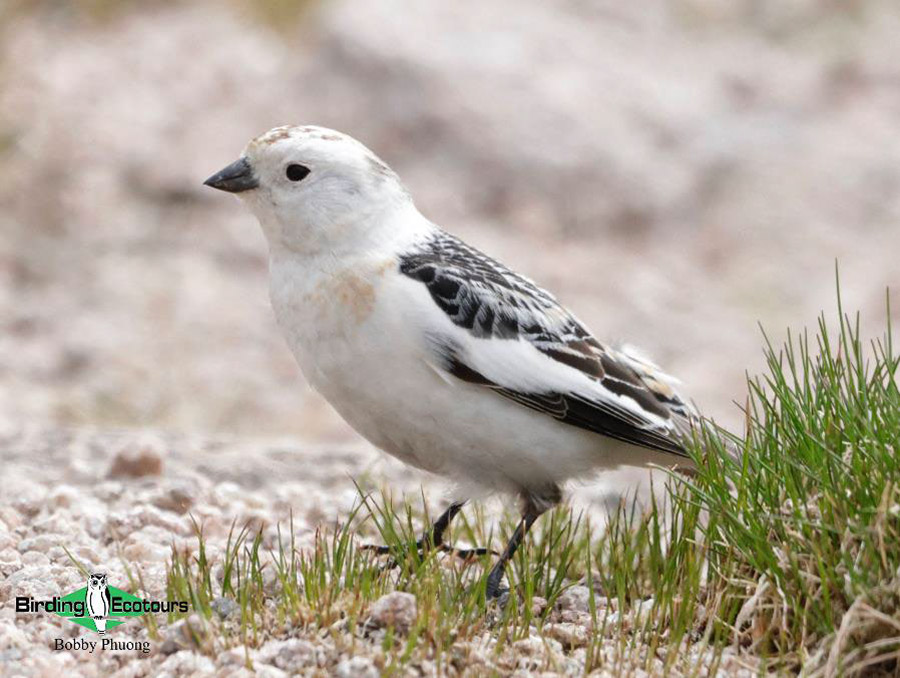
Snow Bunting was great to see in Cairngorms National Park, Scotland.
Overview
This was a wonderful 3.5 week birding, mammal and sightseeing tour of a large part of England and Scotland. During this tour, we saw a good proportion of Britain’s birds, mammals and other wildlife. The tour participants, Dan and Bobby, were great company and, being from New Zealand, most of the fauna was new for them, apart from a handful of British birds that have become established in their home country.
I fetched Bobby and Dan in London and we immediately headed to Knepp, famous for its rewilding. Here, we enjoyed White Storks and listened to the beautiful (and very loud!) songs of Common Nightingales, amongst numerous other birds. We then headed back to London for a bit of sightseeing and the Abba Voyage concert, which was even better than expected, what a spectacular show! We then headed west, visiting Glastonbury, Stonehenge and Highclere Castle where Downton Abbey was filmed (and the third movie is being filmed there as I write this!). We also saw some truly brilliant birds such as Great Bustards on the Salisbury Plain.
The proper birding began, after the more sightseeing-focused “pre-trip” described above, when we headed to Norfolk for five days. Norfolk and adjacent Suffolk in East Anglia are two of Britain’s best birding counties, and we thoroughly enjoyed visiting some of the famous bird reserves in this part of the world. These included the Royal Society for the Protection of Birds (RSPB) Titchwell and Minsmere reserves, and the Norfolk Wildlife Trust (NWT) Cley Marshes reserve.
Three nights in Yorkshire were next on the agenda. Here, we enjoyed seeing White-throated Dippers, Willow Ptarmigan (Red Grouse) and the spectacular seabird colony at RSPB Bempton Cliffs (huge numbers of Northern Gannets and other seabirds breed on the impressive sea cliffs here). Our last bit of birding in England (before heading for the Scottish Highlands) was in Northumberland, where we enjoyed seeing some Black Grouse en route. In Northumberland, we saw some excellent birds and were also treated to a spectacular display of the Northern Lights. There were other distractions from the birding, such as some impressive castles (e.g. the imposing Bamburgh Castle) and the fascinating Holy Island of Lindesfarne. One of the biggest highlights of the entire trip was, however, our boat trip to the Farne Islands, where we got wonderfully close to comical Atlantic Puffins, other beautiful, close-up alcids and various other breeding seabirds.

There were lots of great highlights (besides the birds and other wildlife) on this trip, including a superb Northern Lights show!
We then crossed the border into Scotland, skirting past Edinburgh and driving right through Glasgow, then through Loch Lomond and the Trossachs National Park. We eventually found ourselves at the Scottish Beaver Centre near Knapdale. This stunningly beautiful part of the world allowed us to see Eurasian Beavers, Red Squirrels, our first divers (loons) and lots more. We then headed to the Isle of Mull, part of the Inner Hebrides. This is eagle paradise, and we got great views of Golden Eagle at its eyrie, plus a White-tailed Eagle atop a hill. There were lots of other wonderful birds around in this spectacularly scenic part of the world, including a Surf Scoter visiting from North America.
After an all too short “Mull sampler” (just two nights), we then headed northeast, and spent the last five days of our epic trip around Aviemore to explore the Cairngorms National Park. The Caledonian Pine Forest, birchwoods and beautiful lochs here were a delight to explore and we added many excellent birds and mammals to our trip list. These included Snow Buntings in summer plumage, breeding Pied and Spotted Flycatchers, breeding Black-throated Loons (Divers) and many others.
I eventually dropped Dan and Bobby at Edinburgh airport for their flights home, after a spectacular introduction to British wildlife.
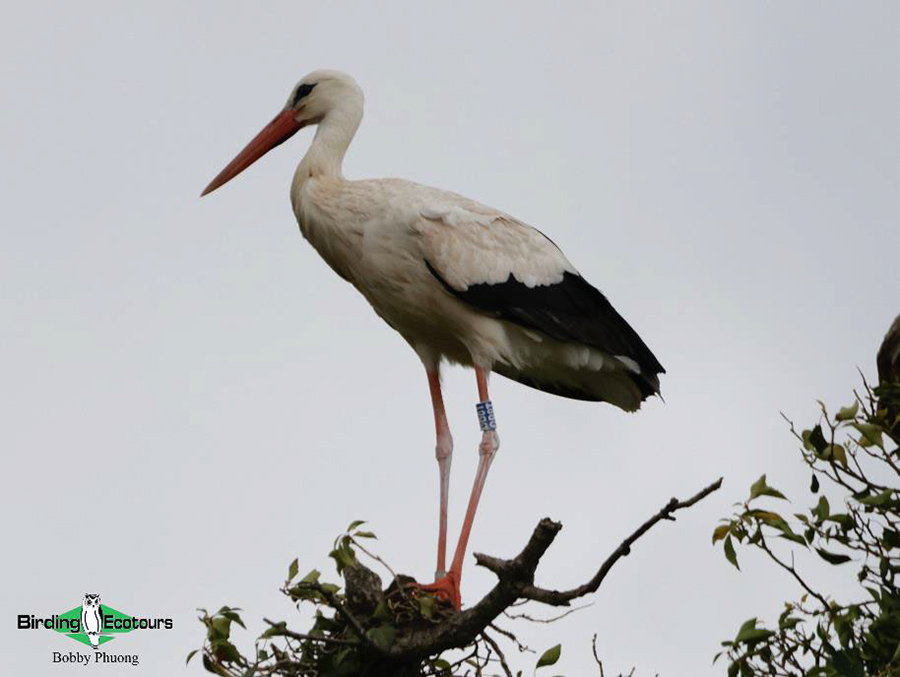
White Stork at Knepp.
Detailed Report
Day 1, 28th April 2024. Arrival in London and transfer to Knepp Rewilding Estate
I fetched Bobby and Dan from Heathrow airport and we immediately embarked on our drive southwards to the Knepp Rewilding Estate, the home of reintroduced White Storks and many other birds. Being from New Zealand and never having birded Britain before, most species were new, and we enjoyed encountering some of our first common English birds such as European Robin, Common Blackbird, White Wagtail, Dunnock, Eurasian Chaffinch, Eurasian Goldfinch, Common Linnet, Eurasian Wren, Song Thrush, Mistle Thrush, Eurasian Blue Tit, Long-tailed Tit, Common Wood Pigeon, Eurasian Collared Dove, Common Moorhen, Grey Heron, Eurasian Magpie, Eurasian Jay, Western Jackdaw, Rook and Carrion Crow. Several warbler species were around; there were many Common Chiffchaffs, Common Whitethroats and Lesser Whitethroats, plus we also found a plain-looking Garden Warbler. One of the star birds at Knepp, which we heard singing beautifully but only glimpsed a couple of times, was Common Nightingale.
European Green Woodpecker and Great Spotted Woodpecker both put in appearances here at Knepp. Raptors came in the form of Eurasian Sparrowhawk, a Common Kestrel and quite a number of beautiful Red Kites.
Our first mammals of the trip were Fallow Deer with nice antlers, European Rabbit and Grey Squirrel.
Day 2, 29th April 2024. Sightseeing and Abba concert in London
We had breakfast near the Worthing Pier on the south coast of England with a view across the English Channel. We got our first decent views of Herring Gull here.
We then headed into central London for some drive-by sightseeing. We drove past the Royal Albert Hall, Buckingham Palace, Westminster Abbey, Big Ben, London Bridge and Tower Bridge. We then headed to a different part of London to the purpose-built Abba Arena, near the Queen Elizabeth Olympic Park area, where we thoroughly enjoyed the spectacular Abba Voyage concert.
Day 3, 30th April 2024. The Salisbury Plain Great Bustards, and Highclere Castle
We embarked on a three-hour drive to the Salisbury Plain, site of Stonehenge and Great Bustards. We enjoyed over 20 bustards on a Great Bustard Group tour. We also saw other excellent birds during this tour, such as a Eurasian Stone-curlew, Northern Lapwing,a pair of close-up Grey Partridges, a few Red-legged Partridges, Corn Buntings, Common Linnets and many others. We also had excellent views of Meadow Pipit, Common Whitethroat, European Stonechat and White Wagtail.There were numerous Red Kites, a couple of Common Buzzards and a Common Kestrel around. Our first Barn Swallow of the trip flew low over.Mammal-wise, we saw some Roe Deer today, albeit a bit distant.
After checking into our bed and breakfast, we went to Highclere Castle where we thoroughly enjoyed the beautiful gardens, followed by an early evening tour of the inside of the building, the setting of Downton Abbey. We also looked at the ancient Egyptian museum section.
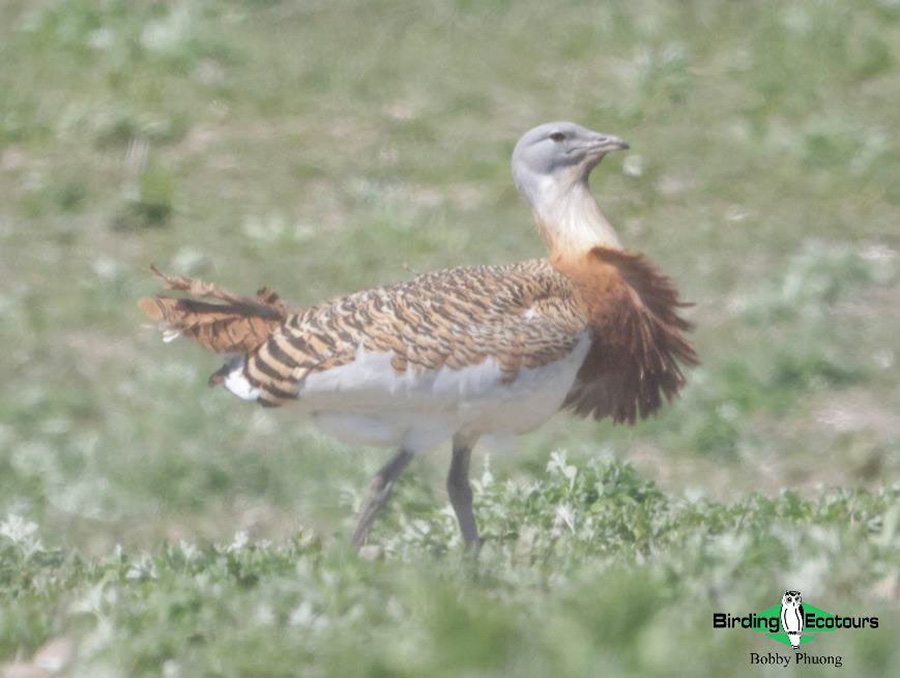
One of over 20 Great Bustards we saw.
Day 4, 1st May 2024. Stonehenge and Glastonbury
After breakfast at our pleasant guest farm accommodation, we took the five-minute drive to Stonehenge. Here, we enjoyed not only this prehistoric megalithic phenomenon made from sarsen stones, but also obtained close-up photographic views of the three more common corvids, Corn Buntings,a male Northern Wheatear, Eurasian Skylarks, and various other birds.
We then explored the town of Glastonbury, including Glastonbury Abbey (allegedly the site of King Arthur’s tomb and with birdy grounds where we saw some new trip birds such as European Greenfinch, Coal Tit and Great Tit at feeders), the site of the Glastonbury Festival, and Glastonbury Tor.
We then continued northwards, bypassing the western side of Bristol, with Wales visible in the distance, and stayed the night at Slimbridge.
Day 5, 2nd May 2024. To Norfolk, arguably Britain’s best birding county!
After an excellent breakfast, we headed to the amazing Cotswold Christmas shop (open year-round) in Lechlade-on-Thames, for an hour. We then embarked on the three-hour drive to the Welney Wetland Centre in western Norfolk near the Cambridgeshire county line. The highlight here was a couple of late Whooper Swans (large flocks of these overwinter here but almost all of them are gone by early May) among large numbers of Mute Swans. We also saw many other new trip birds including Greylag Goose, Common Shelduck, Northern Shoveler, Gadwall, Eurasian Wigeon (these also overwinter in Norfolk in large numbers, but again only a handful remain by early May), Common Pochard, Tufted Duck, Stock Dove, Eurasian Coot, Great Crested Grebe, Eurasian Oystercatcher, Pied Avocet, beautiful breeding plumage Black-tailed Godwit, Common Sandpiper, Common Redshank, Black-headed Gull, Little Egret, Great Egret, Western Marsh Harrier, Cetti’s Warbler and Sedge Warbler (poor views today but we’d see this species very well the next day). One of the target birds here was the scarce Eurasian Tree Sparrow, and we saw a couple of these quite close-up.We also heard the bizarre, deep booming of a Eurasian Bittern.
We then headed to Norwich, which we used as a base for the next five nights to further explore East Anglia.
Day 6, 3rd May 2024. Birding the northeast Norfolk coast
We only started birding in the late morning, and stopped mid-afternoon because of rain, but it was nevertheless another very productive day! We started in Salthouse where we saw and photographed some birds we’d already seen before, but this time really close-up. We then headed slightly further west to the famed Norfolk Wildlife Trust (NWT) Cley Marshes Nature Reserve. We were pleased to add many more new trip birds here. These included Brant Goose (another mainly winter species), Egyptian Goose, Common Swift, Little Grebe, Common Ringed Plover, neat Little Ringed Plover, Eurasian Curlew, a breeding plumage Bar-tailed Godwit (and more breeding plumage Black-tailed Godwits which we’d also seen the previous day), Common Gull (which is actually not particularly common), a flock of five Eurasian Spoonbill flying over, Sand Martin, Common Reed Warbler and some stunning Common Reed Buntings.
We then went to the Sheringham area to look for Firecrest, and were not disappointed, getting eye level views.
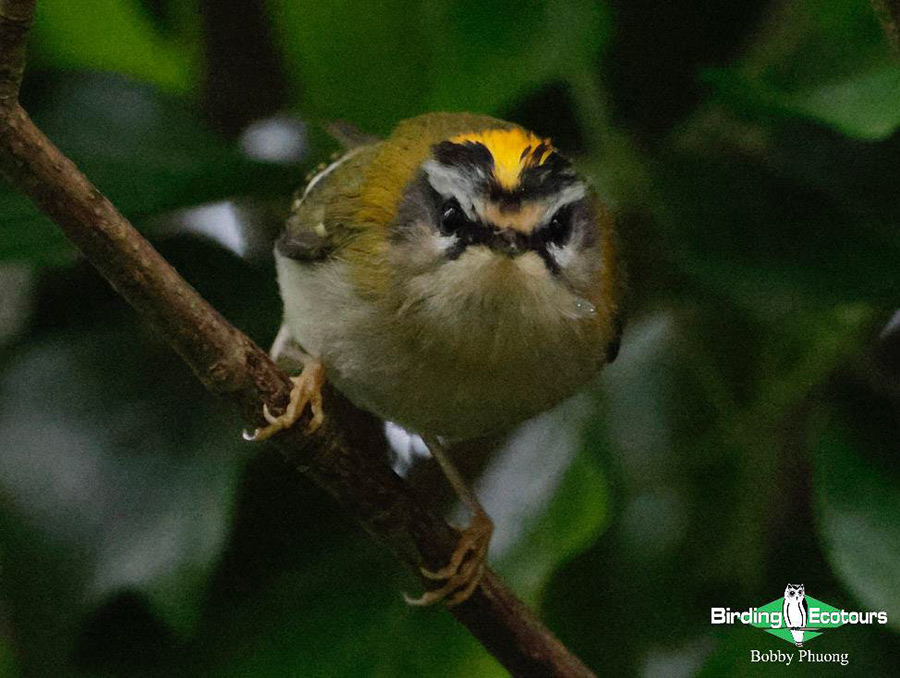
An eye level Firecrest is always a delight to see.
Day 7, 4th May 2024. Birding RSPB Minsmere and other Suffolk birding sites
We started the day at Walberswick on the Suffolk coast, where we saw flocks of Common Scoters out at sea, two Eurasian Whimbrels,some Dunlins in the marshes, a close-up Common Kestrel, and a few other species. We then went to Saxmundham, where Bohemian Waxwings had been present for over a week, but these had sadly gone now, as we discovered. We finally headed to the Royal Society for the Protection of Birds (RSPB) Minsmere nature reserve for the rest of the day. Here at Minsmere, we quickly found a number of new trip birds like Barnacle Goose, Common Tern, Sandwich Tern, Black-legged Kittiwake and Eurasian Blackcap. We then went to the Bittern Hide where we were treated to five Eurasian Bittern sightings as they flew by, many Western Marsh Harriers quartering low over the reeds and some other good birds. On the way back to the visitor center, we saw a cute little deer, Reeve’s Muntjac.
We ended the day at Dunwich Heath, where we saw some Dartford Warblers.
Day 8, 5th May 2024. Birding RSPB Titchwell and Sculthorpe Moore nature reserves
We had a wonderful session at Titchwell, a famous birding reserve in north-western Norfolk. Arguably the best highlight here was seeing Bearded Reedlings nicely. But we sure did also enjoy all the other bird species that were around. These included Mediterranean Gull, Common Cuckoo, some Great Crested Grebes on the calm sea, Eurasian Curlews, a few Sanderlings and many Ruddy Turnstones on the beach.
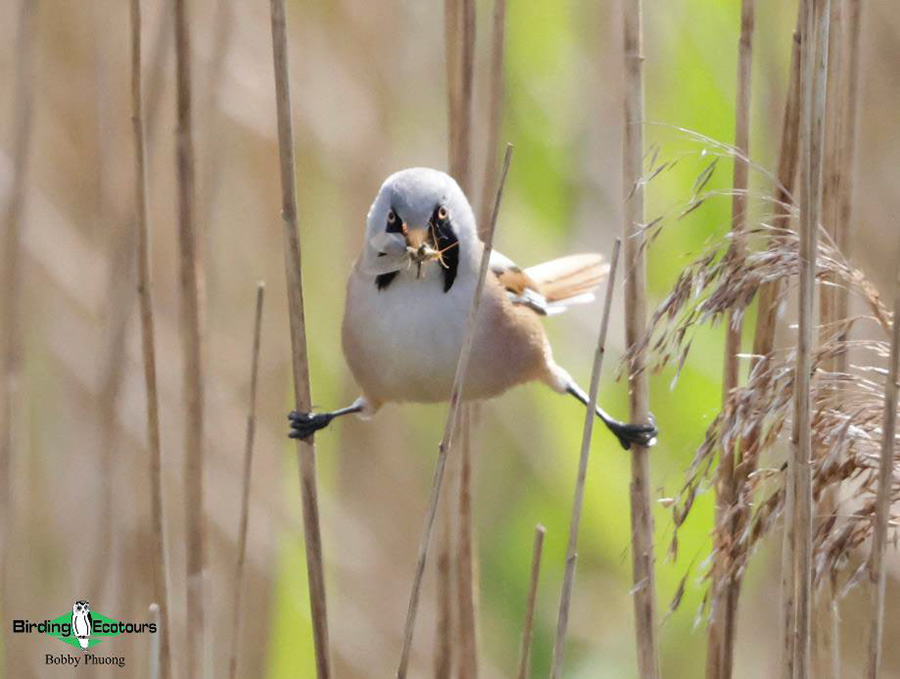
One of the Bearded Reedlings we saw at Titchwell.
We then visited Sculthorpe Moor Nature Reserve, where we enjoyed Tawny Owl at its nest box, Coal Tit, Marsh Tit, Grey Wagtail and various other new birds for the tour.
Day 9, 6th May 2024. Birding Hickling Broad Nature Reserve and Santon Downham
After breakfast, we headed to the largest of the Norfolk Broads, Hickling Broad, where our main target was Common Crane. After a bit of a wait, we eventually saw two flying in and landing, and we managed to scope them from a viewing platform. We also enjoyed listening to some close-up Eurasian Bitterns. About eight Great Egrets put on a flight show for us, as did some Western Marsh Harriers. We saw a gorgeously bright Yellowhammer clearly in freshly molted plumage, shining in the sun along a side road. We improved our views and photos of some species we’d already seen earlier in the trip, e.g. Long-tailed Tit and Eurasian Teal.
We then headed to the Horsey Windpump, where we found our first Willow Warblers of the trip.
We opted to end the day on the other (western) side of Norfolk – on the Suffolk county line – to look for Mandarin Duck. We enjoyed seeing four of these beautiful birds. Another highlight here was a close-up Grey Wagtail, a better view than we’d had previously.
We also saw a couple of non-avian critters today. Mammal-wise, we were pleased to see a Stoat running across the road in front of us, on our way to our first site. We also got brief views of a Palmate Newt.
Day 10, 7th May 2024. Drive to the York area via RSPB Frampton Marsh
We had a superb three or so hour session at RSPB Frampton Marsh in Lincolnshire, conveniently breaking the journey northwards from Norwich to York. A beautiful drake Garganey and quite a close-up Greenshank were two solid new trip birds. Just after enjoying these, we heard that the Red-breasted Goose that had been frequenting this reserve had just been found. We rushed to where it was and, after a bit of scanning, we picked this stunningly beautiful bird out from among a flock of Brant Geese. What a win! A superb-looking rarity. We got better views than previously of Whooper Swan and some Mediterranean Gulls, along with extremely close-up nesting Great Crested Grebes. All in all, not bad for a “travel day” in which we had to get to a new part of England.
Day 11, 8th May 2024. Birding the Howardian Hills, the North York Moors National Park and Scarborough
We started the day in the Castle Howard area, where we were pleased to find our first Goldcrest (albeit high up in a tree), Eurasian Treecreeper (much better views than the Goldcrest!), and a range of other birds we’d already seen earlier in the trip.
We then continued northwards to the North York Moors National Park, one of the largest areas of heather in the UK. Our main target bird at high elevation here was Willow Ptarmigan (the famous Red Grouse) and it co-operated very well. We also enjoyed seeing a close-up Eurasian Curlew on the moor.
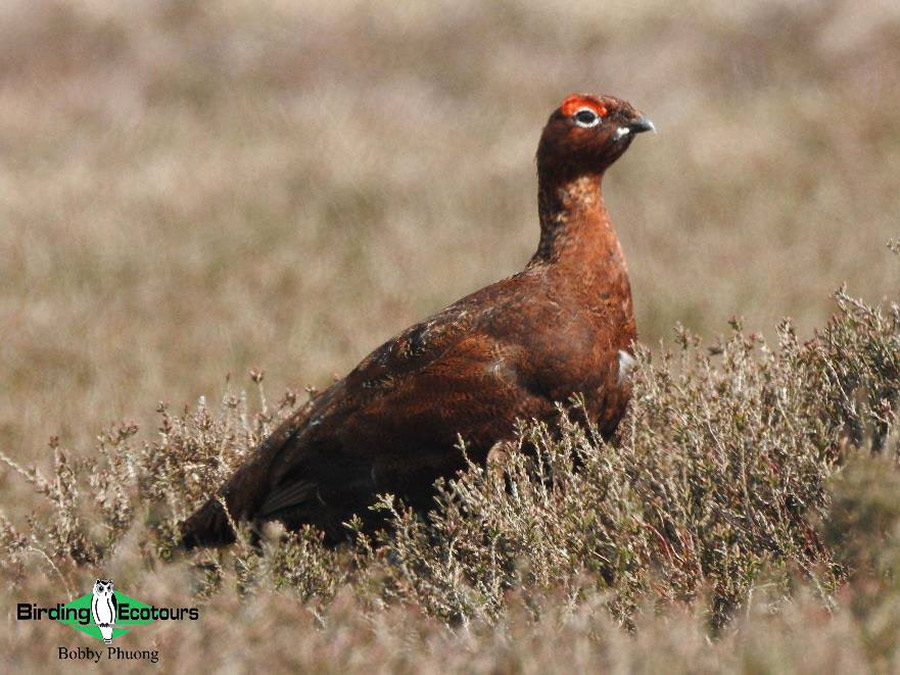
The famous grouse, i.e. the Red Grouse subspecies of Willow Ptarmigan.
Our next stop was in Grosmont (a quaint village and train station) in the valley below. Here, our main target, White-throated Dipper, showed extremely well, along with a pair of Grey Wagtails.
Our final stop for the day was Scarborough, where we saw our first Common Eider (a beautiful drake) and a few other birds.
Day 12, 9th May 2024. RSPB Bempton Cliffs, Filey Dams and Wheldrake Ings birding
Bempton Cliffs RSPB reserve is famous, for good reason. The spectacular sea cliffs are filled with breeding Northern Gannets, Black-legged Kittiwakes, Common Murres and Razorbills. We saw our first two Atlantic Puffins and a couple of Northern Fulmars as well. A pair of Grey Partridges and several Red-legged Partridges were in the grassy fields above the cliffs. We also enjoyed watching a Barn Owl, a couple of Corn Buntings and large numbers of Eurasian Tree Sparrows (generally a scarce bird in the UK).
After a nice lunch at Bempton Cliffs, we drove to the nearby Filey Dams to try and find a Long-tailed Duck that had been reported, but it was MIA. We did see some other nice birds there, but nothing new for the trip.
We ended the day at Weldrake Ings Nature Reserve, where again we found some good birds but nothing new for the tour. Unfortunately, we didn’t see (or hear the diagnostic call of) Willow Tit, our main target here.
Day 13, 10th May 2024. Drive to Northumberland via our Black Grouse site
Today was a fairly long transfer day to Northumberland in northeast England. We enjoyed several birding stops along the way, the best being at our Black Grouse site in the North Pennines Area of Outstanding Natural Beauty (AONB) where we encountered 13 of these handsome birds (all males). We also found another Willow Ptarmigan (Red Grouse) nearby for comparison.
An even bigger tour highlight than Black Grouse awaited us tonight as the Northern Lights (aurora borealis) showed very well – amazing! We saw predictions that it would be not only visible, but also good, in Northumberland, and we were not disappointed!
Day 14, 11th May 2024. Holy Island and Farne Islands boat trip
This was one of the best days of the whole trip. We started the day crossing the causeway onto Holy Island (Lindesfarne), a really spectacular place. On the causeway (that floods during high tide), we got good views of Dunlin, Common Ringed Plovers and Common Eiders, and distant views of breeding plumage Grey Plovers (a better name in this plumage is Black-bellied Plover, a strikingly beautiful bird), a couple of close flyby Little Terns, a few Sandwich Terns and various other birds. We then explored the town of Lindesfarne, the abbey area and the harbor. This is a fascinating place historically (see here for more about that) and it is also a good birding venue. On our way to the harbor, we were very pleased to see our first Common Merganser (Goosander) of the tour, as well as some birds we’d seen already.
After lunch, we joined an incredible boat trip to the Farne Islands. While waiting at the harbor for our boat trip to start, we saw a few Purple Sandpipers and various other good birds we’d seen before, such as Ruddy Turnstones and Common Eiders. We then took the boat to the islands and saw a few Northern Gannets and alcids as we approached the islands. The Farne Islands are inhabited by 90,000 Atlantic Puffins and we got to walk right near them, so we could even take cell phone photos. What a magnificent experience. Tens of thousands of Common Guillemots (Murres), a handful of them with attractive bridles, and Razorbills, also nest here. We enjoyed seeing a small flock of Arctic Terns and a number of Sandwich Terns flying around. Black-legged Kittiwakes, Great Black-backed, Lesser Black-backed, Herring and Black-headed Gulls were also out in force. We saw a single Northern Fulmar. Great Cormorants and breeding plumage European Shags were around.
Mammal-wise, we enjoyed spending some time with a colony of playful Grey Seals towards the end of our boat trip.
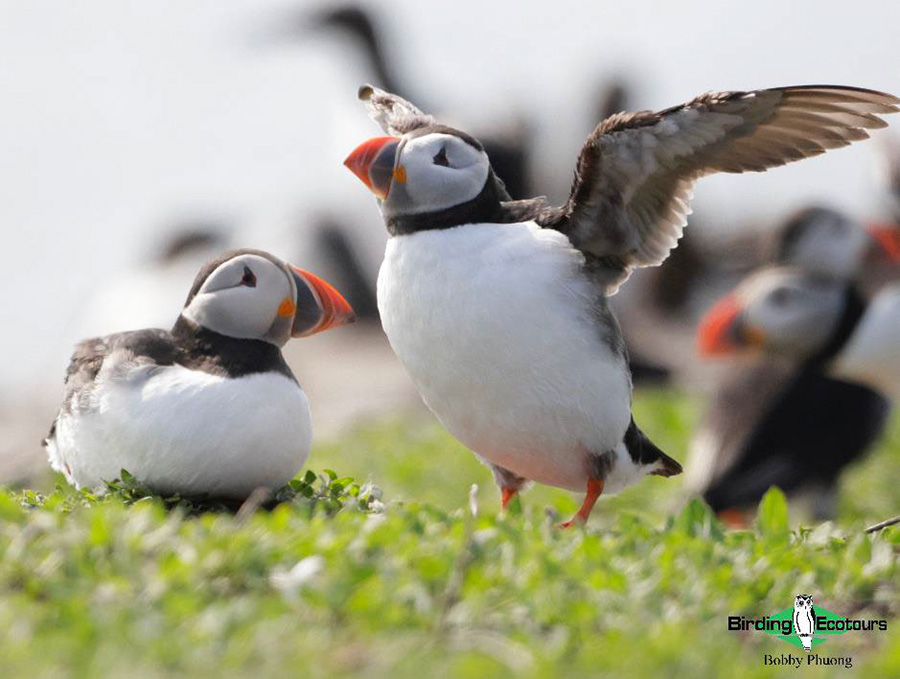
We enjoyed being surrounded by close-up Atlantic Puffins when we landed on the Farne Islands.
Day 15, 12th May 2024. Scottish Beaver Trail
We had a fairly long but very scenic drive today. We headed north and soon crossed the border into Scotland, stopping to take photos of the sign welcoming us to Scotland. We traveled around Edinburgh and then westwards, driving through Glasgow and finally into the scenically spectacular Loch Lomond and the Trossachs National Park. We eventually reached our hotel, which afforded spectacular views from our rooms. We scoped the calm sea from the hotel and found some great new trip birds in the form of summer plumage Common Loon (Great Northern Diver), Red-throated Loon (Diver) distantly, a pair of Red-breasted Mergansers and our first Black Guillemot.
We then went to the Knapdale Scottish Beaver Trail Visitor Centre where we saw a Bank Vole, a Red Squirrel, many Eurasian Siskins, a close-up pair of Great Spotted Woodpeckers and a close-up Eurasian Nuthatch at the feeders. After a visit to Lochgilphead (where we saw our first Hooded Crows for the trip) and dinner, we returned here for an evening session, where we enjoyed seeing two Eurasian Beavers and a Eurasian Otter. Awesome!
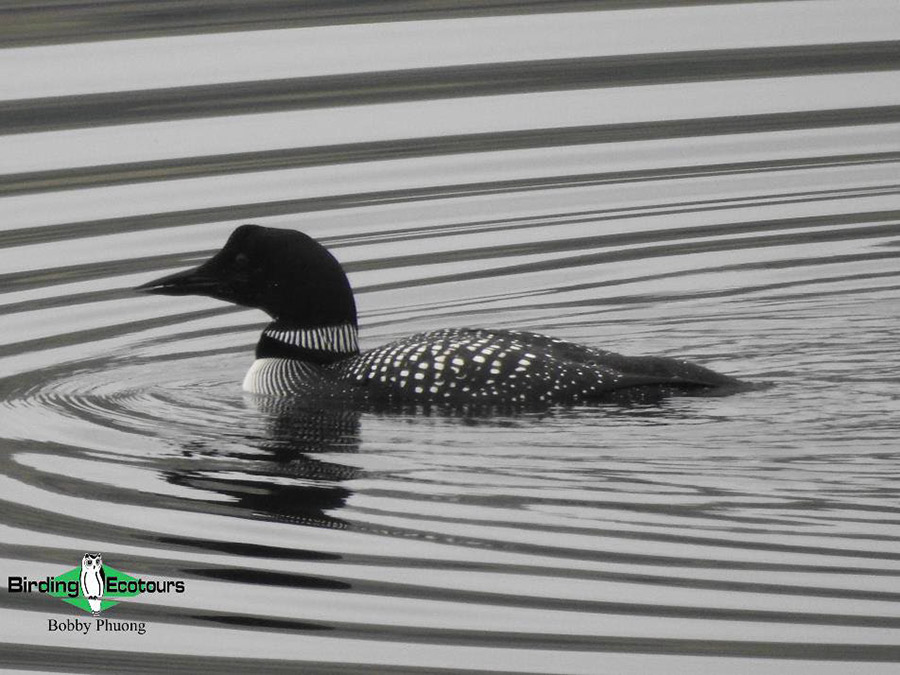
Scotland is great for breeding plumage loons (divers) in spring. This is a Common Loon (Great Northern Diver).
Day 16, 13th May 2024. Ferry crossing to the island of Mull!
We drove from Crinan northwards to Oban where, excitingly, we took a ferry crossing to Mull, the second largest island (after Skye) of the Inner Hebrides. A number of striking summer plumage Black Guillemots showed well in the harbor as we awaited our ferry. A few Common Murres (Common Guillemots) were seen from the ferry.
After landing on Mull (after the hour-long ferry crossing) we had lunch, during which we were rewarded with close views of a displaying European Rock Pipit. We then drove across a chunk of the island, seeing some great wildlife! Species included good numbers of summer plumage Common Loon (Great Northern Diver), a beautiful male Common Merganser (Goosander) and several Red-breasted Mergansers, White-tailed Eagle, a pair of Northern Ravens and many Hooded Crows.
Day 17, 14th May 2024. Full day on the island of Mull
Despite light drizzle, this was a super-amazing day in which we must have covered around 60 % of the roads of the scenically spectacular island of Mull. As we traversed the island, we enjoyed many species we’d already seen on previous days, plus some new ones. Quite close-up singing Tree Pipits were a delight. We then saw a couple of Common (Harbor) Seals. One of the major highlights of the day was a good view of an American vagrant Surf Scoter that had been present for at least a week, according to rare bird reports.
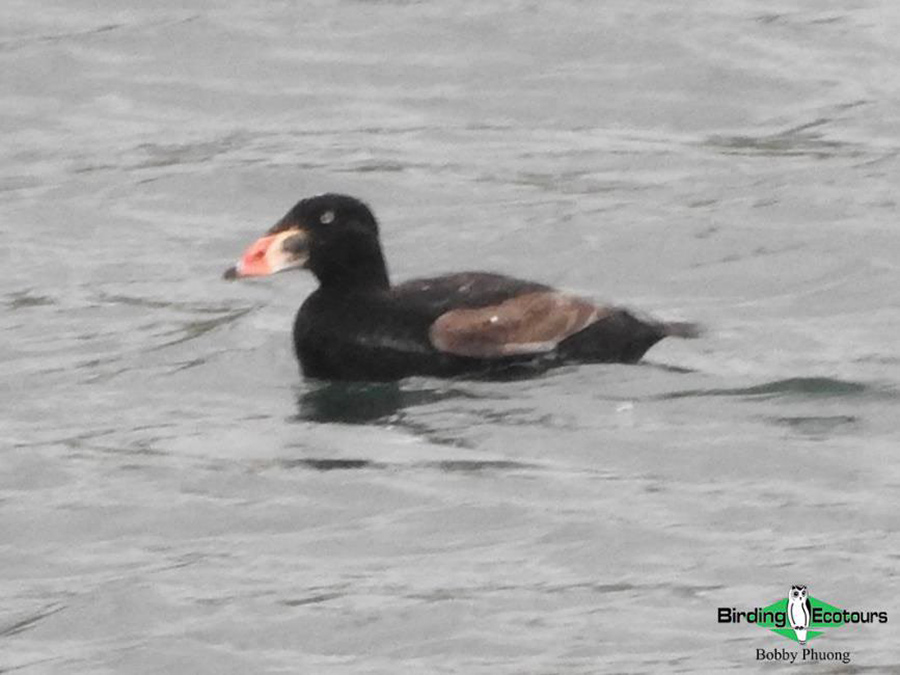
An American vagrant in Scotland, Surf Scoter.
Day 18, 15th May 2024. Mull to Aviemore
After yesterday’s drizzle, we were pleased to wake up to a warm sunshiny day. We were rewarded with good views of a Golden Eagle near its nest. At one point this majestic bird sat in a small tree, then on different rocks after a couple of short flights. We glimpsed its partner on the nest itself, but most of the time it was invisible.
We had to leave the island around lunchtime to comfortably make it to our next destination in a different part of Scotland before dinner, including time for birding stops. We traversed spectacular scenery and did two more ferry crossings (Fishnish to Lochaline and Ardgour to Corran), off the island of Mull and northeastwards on our way to the Cairngorms National Park area where we would spend the last five nights of our trip. Shortly after the second ferry, we found a small flock of Northern Ravens.En route towards Fort William, the last west coast town before we headed inland, we stopped to look at a Wood Warbler we heard singing as we were driving. We also saw a Eurasian Treecreeper and various other woodland birds at this stop. Nearby, we enjoyed seeing some Red-throated Loons (Divers) and a few other nice species.
Day 19, 16th May 2024. Star mammals of the Aviemore area
We started the day among the Cairngorm Reindeer herd, one of the biggest trip highlights for Dan and Bobby who got to hand feed these gentle animals. After lunch, we took a break, noting we were going to have a late night tonight. After an early dinner, we set off around 6.30 pm for a short stint of evening birding at Avielochan. Here, we enjoyed seeing a superbly smart-looking breeding plumage Horned (Slavonian) Grebe, a Common Goldeneye, an Osprey, a Mistle Thrush and various other goodies. We then headed to our mammal hide for an amazing evening that finished around midnight. At this hide, we got close-up views of at least five European Badgers, a European Pine Marten, a Bank Vole and a few Wood Mice (Long-tailed Field Mice). We heard Eurasian Woodcock and Tawny Owl while at the hide. We just missed a Scottish Wildcat that some late arrivers to the hide saw in the carpark once we’d already settled into the hide.
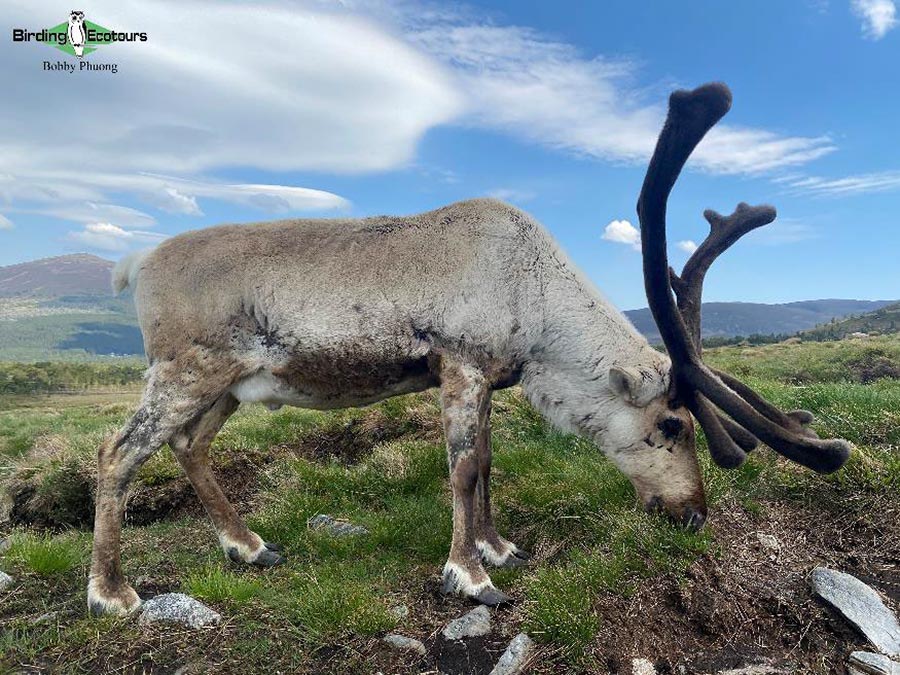
Reindeer!
Day 20, 17th May 2024. High altitude birding
We spent a large part of the day doing the strenuous walk to the Cairngorm Ski Area and then beyond. The highlights were some beautiful summer plumage Snow Buntings, some rather distant male Ring Ouzels and a Mountain Hare. Very unfortunately, we narrowly missed Rock Ptarmigan, which others said had just been around.
Day 21, 18th May 2024. Birding RSBP Loch Garten Nature Reserve and Abernethy National Nature Reserve
We spent a relaxed day birding these beautiful forest reserves with their lovely lakes. We did not find any new birds or mammals for the trip, although we heard Crested Tit. We did get greatly improved views of some species, such as Goldcrest.
Day 22, 19th May 2024. Lochindorb, Nethy Bridge and Craigellachie National Nature Reserve
We started the day with a visit to Lochindorb, where we saw our target bird, a smart summer plumage Black-throated Loon (Diver), with ease. We also enjoyed seeing a couple more Willow Ptarmigans (Red Grouse) here. Just before getting to this loch, we also saw close up Common Cuckoos,which were very vocal too. The road goes straight through a breeding colony of Common Gulls, so we were surrounded by these neat birds.
We had lunch at Nethy Bridge, where we enjoyed close views of a White-throated Dipper feeding its baby. We then proceeded to Craigellachie Nature Reserve, where we obtained excellent views of a European Flycatcher and a quicker view of a Spotted Flycatcher. There were numerous other birds around which we’d seen before, such as Long-tailed Tits, stacks of Willow Warblers and a Eurasian Treecreeper, to name a few. We also saw hundreds of tadpoles, and a couple of Palmate Newts in the ponds.
Day 23, 20th May 2024. Transfer to Edinburgh airport for flights home
Sadly the tour came to an end with a transfer to the airport.
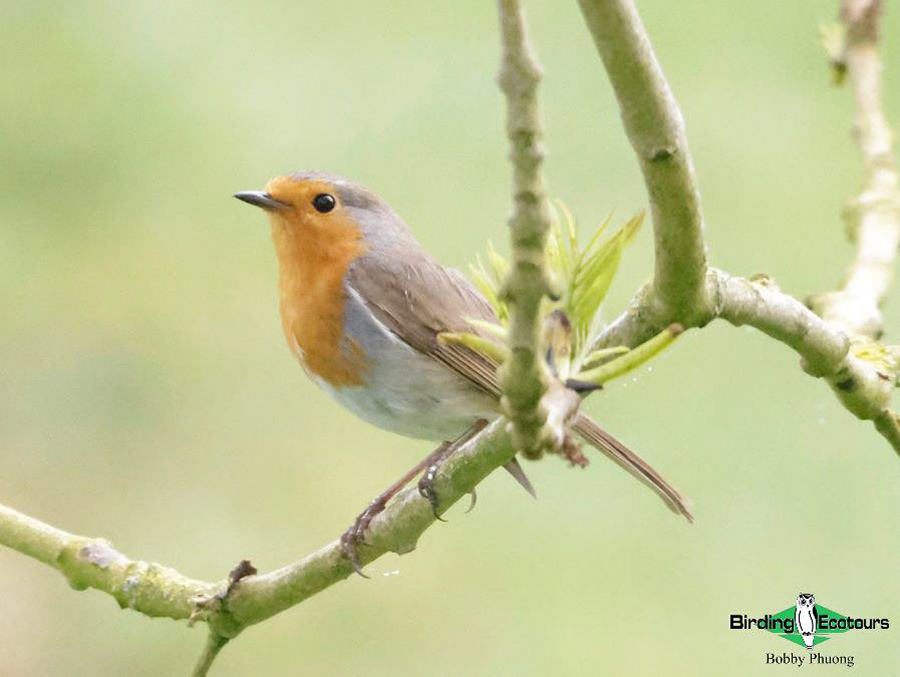
Some of the common British birds like this European Robin were major tour highlights.
Bird List – Following IOC 14.1
Birds ‘heard only’ are marked with (H) after the common name, all other species were seen.
The following notation after species names is used to show conservation status following BirdLife International: CR = Critically Endangered, EN = Endangered, VU = Vulnerable, NT = Near Threatened.
| Common name | Scientific name |
| Ducks, Geese, Swans (Anatidae) | |
| Brant Goose | Branta bernicla |
| Red-breasted Goose – VU | Branta ruficollis |
| Canada Goose | Branta canadensis |
| Barnacle Goose | Branta leucopsis |
| Greylag Goose | Anser anser |
| Mute Swan | Cygnus olor |
| Whooper Swan | Cygnus cygnus |
| Egyptian Goose | Alopochen aegyptiaca |
| Common Shelduck | Tadorna tadorna |
| Mandarin Duck | Aix galericulata |
| Garganey | Spatula querquedula |
| Northern Shoveler | Spatula clypeata |
| Gadwall | Mareca strepera |
| Eurasian Wigeon | Mareca penelope |
| Mallard | Anas platyrhynchos |
| Eurasian Teal | Anas crecca |
| Common Pochard – VU | Aythya ferina |
| Tufted Duck | Aythya fuligula |
| Common Eider | Somateria mollissima |
| Surf Scoter | Melanitta perspicillata |
| Common Scoter | Melanitta nigra |
| Common Goldeneye | Bucephala clangula |
| Common Merganser | Mergus merganser |
| Red-breasted Merganser | Mergus serrator |
| Pheasants & Allies (Phasianidae) | |
| Willow Ptarmigan | Lagopus lagopus |
| Black Grouse | Lyrurus tetrix |
| Grey Partridge | Perdix perdix |
| Common Pheasant | Phasianus colchicus |
| Red-legged Partridge | Alectoris rufa |
| Swifts (Apodidae) | |
| Common Swift | Apus apus |
| Bustards (Otididae) | |
| Great Bustard – EN | Otis tarda |
| Cuckoos (Cuculidae) | |
| Common Cuckoo | Cuculus canorus |
| Pigeons, Doves (Columbidae) | |
| Rock Dove | Columba livia |
| Stock Dove | Columba oenas |
| Common Wood Pigeon | Columba palumbus |
| Eurasian Collared Dove | Streptopelia decaocto |
| Rails, Crakes & Coots (Rallidae) | |
| Common Moorhen | Gallinula chloropus |
| Eurasian Coot | Fulica atra |
| Cranes (Gruidae) | |
| Common Crane | Grus grus |
| Grebes (Podicipedidae) | |
| Little Grebe | Tachybaptus ruficollis |
| Great Crested Grebe | Podiceps cristatus |
| Horned Grebe – VU | Podiceps auritus |
| Stone-curlews, Thick-knees (Burhinidae) | |
| Eurasian Stone-curlew | Burhinus oedicnemus |
| Oystercatchers (Haematopodidae) | |
| Eurasian Oystercatcher | Haematopus ostralegus |
| Stilts, Avocets (Recurvirostridae) | |
| Pied Avocet | Recurvirostra avosetta |
| Plovers (Charadriidae) | |
| Grey Plover | Pluvialis squatarola |
| Common Ringed Plover | Charadrius hiaticula |
| Little Ringed Plover | Charadrius dubius |
| Northern Lapwing | Vanellus vanellus |
| Sandpipers, Snipes (Scolopacidae) | |
| Eurasian Whimbrel | Numenius phaeopus |
| Eurasian Curlew | Numenius arquata |
| Bar-tailed Godwit | Limosa lapponica |
| Black-tailed Godwit | Limosa limosa |
| Common Sandpiper | Actitis hypoleucos |
| Eurasian Woodcock (H) | Scolopax rusticola |
| Common Redshank | Tringa totanus |
| Common Greenshank | Tringa nebularia |
| Ruddy Turnstone | Arenaria interpres |
| Sanderling | Calidris alba |
| Dunlin | Calidris alpina |
| Purple Sandpiper | Calidris maritima |
| Gulls, Terns, Skimmers (Laridae) | |
| Little Tern | Sternula albifrons |
| Arctic Tern | Sterna paradisaea |
| Common Tern | Sterna hirundo |
| Sandwich Tern | Thalasseus sandvicensis |
| Black-legged Kittiwake – VU | Rissa tridactyla |
| Black-headed Gull | Chroicocephalus ridibundus |
| Mediterranean Gull | Ichthyaetus melanocephalus |
| Common Gull | Larus canus |
| European Herring Gull | Larus argentatus |
| Great Black-backed Gull | Larus marinus |
| Lesser Black-backed Gull | Larus fuscus |
| Auks (Alcidae) | |
| Atlantic Puffin – VU | Fratercula arctica |
| Black Guillemot | Cepphus grylle |
| Razorbill | Alca torda |
| Common Murre | Uria aalge |
| Loons (Gaviidae) | |
| Red-throated Loon | Gavia stellata |
| Black-throated Loon | Gavia arctica |
| Common Loon | Gavia immer |
| Petrels, Shearwaters, Diving Petrels (Procellariidae) | |
| Northern Fulmar | Fulmarus glacialis |
| Storks (Ciconiidae) | |
| White Stork | Ciconia ciconia |
| Gannets, Boobies (Sulidae) | |
| Northern Gannet | Morus bassanus |
| Cormorants, Shags (Phalacrocoracidae) | |
| Great Cormorant | Phalacrocorax carbo |
| European Shag | Gulosus aristotelis |
| Ibises, Spoonbills (Threskiornithidae) | |
| Eurasian Spoonbill | Platalea leucorodia |
| Herons, Bitterns (Ardeidae) | |
| Eurasian Bittern | Botaurus stellaris |
| Little Egret | Egretta garzetta |
| Great Egret | Ardea alba |
| Grey Heron | Ardea cinerea |
| Ospreys (Pandionidae) | |
| Osprey | Pandion haliaetus |
| Kites, Hawks, Eagles (Accipitridae) | |
| Golden Eagle | Aquila chrysaetos |
| Eurasian Sparrowhawk | Accipiter nisus |
| Western Marsh Harrier | Circus aeruginosus |
| Red Kite | Milvus milvus |
| White-tailed Eagle | Haliaeetus albicilla |
| Common Buzzard | Buteo buteo |
| Barn Owls (Tytonidae) | |
| Western Barn Owl | Tyto alba |
| Owls (Strigidae) | |
| Tawny Owl | Strix aluco |
| Woodpeckers (Picidae) | |
| Great Spotted Woodpecker | Dendrocopos major |
| European Green Woodpecker | Picus viridis |
| Caracaras, Falcons (Falconidae) | |
| Common Kestrel | Falco tinnunculus |
| Eurasian Hobby | Falco subbuteo |
| Old World Parrots (Psittaculidae) | |
| Rose-ringed Parakeet | Psittacula krameri |
| Crows, Jays (Corvidae) | |
| Eurasian Jay | Garrulus glandarius |
| Eurasian Magpie | Pica pica |
| Western Jackdaw | Coloeus monedula |
| Rook | Corvus frugilegus |
| Carrion Crow | Corvus corone |
| Hooded Crow | Corvus cornix |
| Northern Raven | Corvus corax |
| Tits, Chickadees (Paridae) | |
| Coal Tit | Periparus ater |
| Crested Tit (H) | Lophophanes cristatus |
| Marsh Tit | Poecile palustris |
| Eurasian Blue Tit | Cyanistes caeruleus |
| Great Tit | Parus major |
| Bearded Reedling (Panuridae) | |
| Bearded Reedling | Panurus biarmicus |
| Larks (Alaudidae) | |
| Eurasian Skylark | Alauda arvensis |
| Swallows, Martins (Hirundinidae) | |
| Sand Martin | Riparia riparia |
| Barn Swallow | Hirundo rustica |
| Western House Martin | Delichon urbicum |
| Cettia Bush Warblers & Allies (Cettiidae) | |
| Cetti’s Warbler | Cettia cetti |
| Bushtits (Aegithalidae) | |
| Long-tailed Tit | Aegithalos caudatus |
| Leaf Warblers (Phylloscopidae) | |
| Wood Warbler | Phylloscopus sibilatrix |
| Willow Warbler | Phylloscopus trochilus |
| Common Chiffchaff | Phylloscopus collybita |
| Reed Warblers & Allies (Acrocephalidae) | |
| Sedge Warbler | Acrocephalus schoenobaenus |
| Common Reed Warbler | Acrocephalus scirpaceus |
| Sylviid Babblers (Sylviidae) | |
| Eurasian Blackcap | Sylvia atricapilla |
| Garden Warbler | Sylvia borin |
| Lesser Whitethroat | Curruca curruca |
| Common Whitethroat | Curruca communis |
| Dartford Warbler | Curruca undata |
| Goldcrests, Kinglets (Regulidae) | |
| Common Firecrest | Regulus ignicapilla |
| Goldcrest | Regulus regulus |
| Wrens (Troglodytidae) | |
| Eurasian Wren | Troglodytes troglodytes |
| Nuthatches (Sittidae) | |
| Eurasian Nuthatch | Sitta europaea |
| Treecreepers (Certhiidae) | |
| Eurasian Treecreeper | Certhia familiaris |
| Starlings, Rhabdornises (Sturnidae) | |
| Common Starling | Sturnus vulgaris |
| Thrushes (Turdidae) | |
| Song Thrush | Turdus philomelos |
| Mistle Thrush | Turdus viscivorus |
| Common Blackbird | Turdus merula |
| Chats, Old World Flycatchers (Muscicapidae) | |
| Spotted Flycatcher | Muscicapa striata |
| European Robin | Erithacus rubecula |
| Common Nightingale | Luscinia megarhynchos |
| European Pied Flycatcher | Ficedula hypoleuca |
| European Stonechat | Saxicola rubicola |
| Northern Wheatear | Oenanthe oenanthe |
| Dippers (Cinclidae) | |
| White-throated Dipper | Cinclus cinclus |
| Old World Sparrows, Snowfinches (Passeridae) | |
| Eurasian Tree Sparrow | Passer montanus |
| House Sparrow | Passer domesticus |
| Accentors (Prunellidae) | |
| Dunnock | Prunella modularis |
| Wagtails, Pipits (Motacillidae) | |
| Grey Wagtail | Motacilla cinerea |
| White Wagtail | Motacilla alba |
| Meadow Pipit | Anthus pratensis |
| Tree Pipit | Anthus trivialis |
| European Rock Pipit | Anthus petrosus |
| Finches, Euphonias (Fringillidae) | |
| Eurasian Chaffinch | Fringilla coelebs |
| European Greenfinch | Chloris chloris |
| Common Linnet | Linaria cannabina |
| European Goldfinch | Carduelis carduelis |
| Eurasian Siskin | Spinus spinus |
| Longspurs, Snow Buntings (Calcariidae) | |
| Snow Bunting | Plectrophenax nivalis |
| Buntings (Emberizidae) | |
| Corn Bunting | Emberiza calandra |
| Yellowhammer | Emberiza citrinella |
| Common Reed Bunting | Emberiza schoeniclus |
| Total seen | 163 |
| Total heard only | 2 |
| Total recorded | 165 |
Mammal List – Following Mammalwatching.com
| Common name | Scientific name | |
| Hares and Rabbits (Leporidae) | ||
| European Hare | Lepus europaeus | |
| Mountain Hare | Lepus timidus | |
| European Rabbit – EN | Oryctolagus cuniculus | |
| Squirrels (Sciuridae) | ||
| Eastern Gray Squirrel | Sciurus carolinensis | |
| Eurasian Red Squirrel | Sciurus vulgaris | |
| Beavers (Castoridae) | ||
| Eurasian Beaver | Castor fiber | |
| Hamsters, Voles, Lemmings, and Allies (Cricetidae) | ||
| Bank Vole | Clethrionomys glareolus | |
| Old World Mice and Rats (Muridae) | ||
| Long-tailed Field Mouse | Apodemus sylvaticus | |
| Brown Rat | Rattus norvegicus | |
| Mustelids (Mustelidae) | ||
| European Pine Marten | Martes martes | |
| Eurasian Otter | Lutra lutra | |
| European Badger | Meles meles | |
| Beringian Ermine | Mustela erminea | |
| Earless Seals (Phocidae) | ||
| Gray Seal | Halichoerus grypus | |
| Harbor Seal | Phoca vitulina | |
| Deer (Cervidae) | ||
| Western Roe Deer | Capreolus capreolus | |
| Caribou – VU | Rangifer tarandus | |
| Western Red Deer | Cervus elaphus | |
| Common Fallow Deer | Dama dama | |
| Reeves’s Muntjac | Muntiacus reevesi | |
| Oceanic Dolphins (Delphinidae) | ||
| Common Bottlenose Dolphin | Tursiops truncatus | |
| Total seen | 21 | |
This is a sample trip report. Please email us ([email protected]) for more trip reports from this destination.
